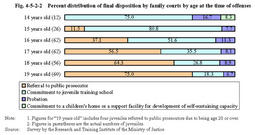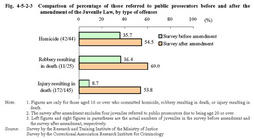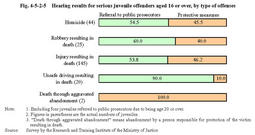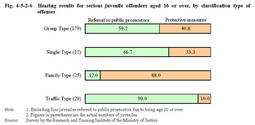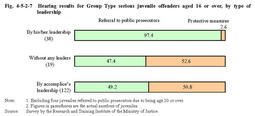| Previous Next Index Image Index Year Selection | |
|
|
1 Hearings in family courts (1) Outline of hearings Among278juveniles(see the preface of this Chapter ),four were referred to public prosecutors due to being age20or over,138(49.6%)were referred to public prosecutors for criminal prosecution,and136(48.9%)were given protective measures by family courts.
Fig.4-5-2-1 shows the percent distribution of final disposition at family courts by type of offenses. The percentage of those referred to public prosecutors(including those due to being age20or over,)was highest for unsafe driving resulting in death at90.0%,followed by robbery resulting in death at51.7%.Two juveniles for death through aggravated abandonment(abandonment by a person responsible for protection of the victim resulting in death)were both females. Fig.4-5-2-1 Percent distribution of final disposition by family courts by type of offenses Fig.4-5-2-2 shows the percent distribution of final disposition at family courts by age at the time of offenses.As for juveniles aged16or over,the percentage of those referred to public prosecutors(including those due to being age20or over,)became higher according to age.Three juveniles aged15(including one aged16at the time of court disposition)were first referred to public prosecutors,but transferred to family courts after prosecution to be placed under protective measures in the end. Fig.4-5-2-2 Percent distribution of final disposition by family courts by age at the time of offenses (2) Comparison of hearing results before and after the amendment of the Juvenile Law We will make a comparison between surveys on serious juvenile cases conducted by the Correctional Association Research Institute for Criminology before the enforcement of the Amended Juvenile Law(in1999and2000;hereinafter referred to as the"survey before amendment")and the current special survey(see the preface of this Chapter ;hereinafter referred to as the"survey after amendment").Among object person of these surveys,we will pick up juveniles aged16or over who committed homicide,injury resulting in death,or robbery resulting in death to examine changes in the results of hearings.The survey before amendment adopted juveniles'age at the time of entry to juvenile classification homes for protective detention,while the survey after amendment adopted juveniles'age at the time of offenses.Accurate comparison is difficult due to this difference in age classification,but it is still meaningful to compare the hearing results before and after the amendment of the Juvenile Law to overview the operation of the Amended Juvenile Law.
Fig.4-5-2-3 shows the comparison of the percentages of juveniles referred to public prosecutors before and after the amendment of the Juvenile Law,by type of offenses. The percentages of those referred to public prosecutors rose significantly for all types of offenses in the survey after amendment,compared to those in the survey before amendment.In particular there was a sharp rise from8.7%(the survey before amendment)to53.8%(the survey after amendment)in the percentage of those referred to public prosecutors for injury resulting in death. Fig.4-5-2-3 Comparison of percentage of those referred to public prosecutors before and after the amendment of the Juvenile Law,by type of offenses Fig.4-5-2-4 shows the comparison of the percentages of juveniles referred to public prosecutors before and after the amendment of the Juvenile Law,by age.In both surveys,the percentage of those referred to public prosecutors became higher according to age.However,the percentage of those aged18or younger who were referred to public prosecutors notably rose in the survey after amendment. Fig.4-5-2-4 Comparison of percentage of those referred to public prosecutors before and after the amendment of the Juvenile Law,by age (3) Hearing of cases where juveniles aged 16 or over killed victims The percentage of those referred to public prosecutors increased after the amendment of the Juvenile Law,but among the236serious juvenile offenders aged16or over at the time of offenses(excluding four juveniles referred to public prosecutors due to being age20or over),135(57.2%)were referred to public prosecutors and the remaining101(42.8%)were given protective measures.Therefore,we will examine what kinds of factors affected the decision of referral to public prosecutors or protective measures.
Fig.4-5-2-5 shows hearing results for serious juvenile offenders aged16or over,by type of offenses. Most of those who committed unsafe driving resulting in death were referred to public prosecutors,except for cases in which juveniles were16at the time of offenses.In cases of robbery resulting in death and injury resulting in death,juveniles involved in cases led by adult accomplices were placed under protective measures.Most juveniles placed under protective measures for homicide were Family Type ones,such as females who killed their new-born baby. Fig.4-5-2-5 Hearing results for serious juvenile offenders aged16or over,by type of offenses Fig.4-5-2-6 shows hearing results for serious juvenile offenders aged16or over,by classification type of offenses.Traffic Type cases were all unsafe driving resulting in death,and90.0%of juveniles of this type were referred to public prosecutors. In contrast,88.0%of Family Type juvenile offenders were placed under protective measures.A male who tortured his child to death,and males who were nearly20at the time of hearing were referred to public prosecutors.As mentioned above,the percentage of protective measures was high in the case of Family Type juvenile offenders,which included many cases where father victims had problems of alcoholism or violence,juvenile offenders had mental disabilities,and females killed their new-born babies,etc. Among Single Type cases,four juveniles(33.3%)out of12were placed under protective measures.These included cases where a juvenile was recognized to have mental disabilities and a victim had been stalking a female perpetrator. Fig.4-5-2-6 Hearing results for serious juvenile offenders aged16or over,by classification type of offenses We will further examine the hearing results and other factors for the Group Type,which includes179serious juvenile offenders,and73(40.8%)of them were placed under protective measures.Fig.4-5-2-7 shows hearing results for Group Type serious juvenile offenders aged16or over,by type of leadership. Fig.4-5-2-7 Hearing results for Group Type serious juvenile offenders aged16or over,by type of leadership In order to examine the relation between the hearing results for Group Type juvenile offenders and their level of violence,we classified them into four categories,"strong,""medium,""weak,"and"no violence,"according to their level of violence,based on data by the Research and Training Institute of the Ministry of Justice.The percentage of referral to public prosecutors was considerably high at89.6%for those classified into"strong,"followed by58.2%for"medium,"28.1%for"no violence,"and20.0%for"weak."Those classified into"no violence"showed a higher percentage than those classified into"weak,"because the former included senior juveniles who played a leading role in giving directions but did not use violence directly at the time of offenses.Some juveniles who used violence on their senior accomplices'order were placed under protective measures,in spite of their"strong"level of violence.Looking at the hearing results for Group Type juvenile offenders and their age and a history of receiving disposition of protective measures,the percentage of referral to public prosecutors rose according to age at the time of offenses.The percentage was45.1%for those aged16,60.8%for those aged17,59.5%for those aged18,and77.1%for those aged19.By a history of receiving disposition of protective measures,the percentage of referral to public prosecutors was52.8%for those who had never been placed under probationary supervision,71.1%for those placed under probationary supervision once,and100.0%for those placed under probationary supervision twice.Furthermore,the percentage was56.7%for those who had never been committed to juvenile training schools,84.6%for those committed to juvenile training schools once,and100.0%for those committed to juvenile training schools twice.Those who received disposition of protective measures a greater number of times showed a higher percentage of referral to public prosecutors. As for Group Type juvenile offenders,it is recognized that the decision of referral to public prosecutors or protective measures is made,depending on various factors,such as their age,history of protective measures,and facts of whether they were leaders and how much detrimental damages they caused to victims. |

